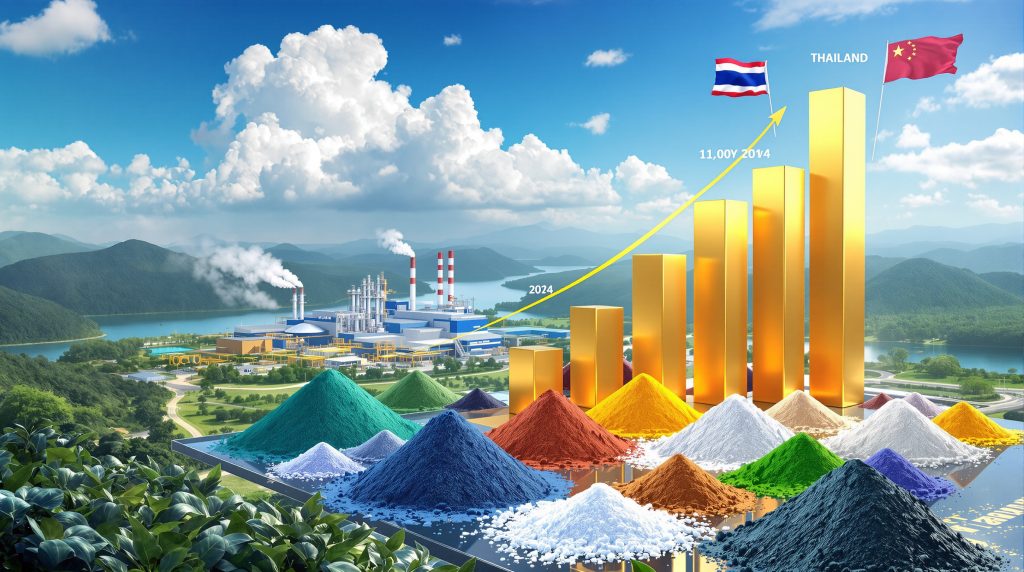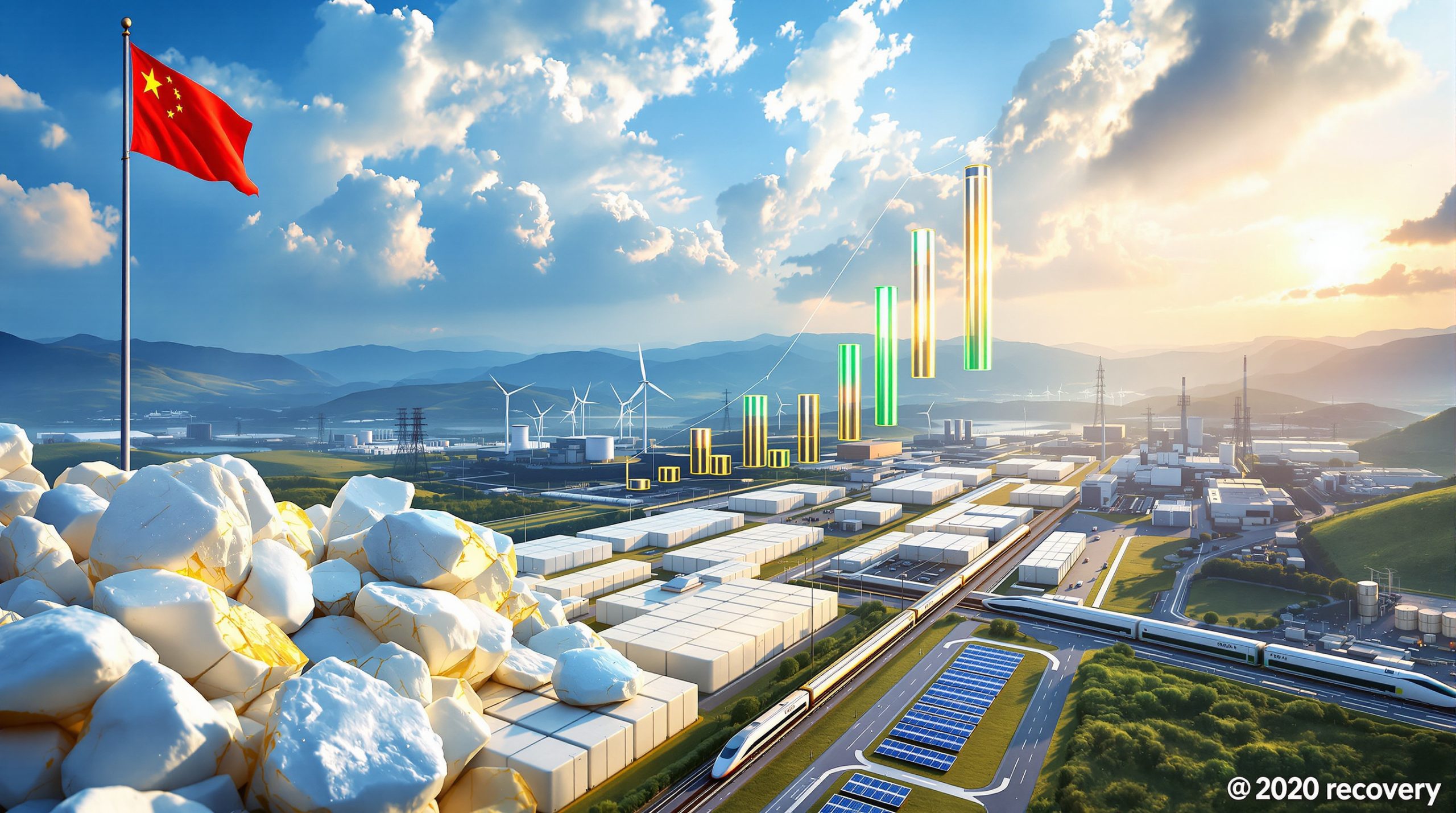Thailand's dramatic expansion in rare earth element production represents more than simple resource extraction. The Southeast Asian kingdom has positioned itself as a critical intermediary in global supply chain restructuring, leveraging diplomatic neutrality and geographic advantages to capture processing value while major powers compete for mineral security. Furthermore, this Thailand rare earth supply chain strategy demonstrates how emerging economies can navigate complex geopolitical dynamics while building industrial capabilities.
Recent production data reveals Thailand's remarkable trajectory in the rare earth sector. From minimal output levels in previous years, the country achieved approximately 13,000 metric tons of rare earth production in 2024, marking a substantial increase in its contribution to global supply chains. This growth positions Thailand among emerging producers in the Asia-Pacific region, though production volumes remain modest compared to dominant suppliers.
The kingdom's approach differs fundamentally from traditional resource-based strategies. Rather than pursuing upstream mining operations, Thailand focuses on downstream processing and diplomatic positioning. In addition, this approach creates opportunities to add value without requiring extensive domestic mineral reserves, particularly as the critical minerals transition accelerates globally.
Strategic Diplomacy Through Critical Minerals Cooperation
Thailand's October 2025 Memorandum of Understanding with the United States represents calculated economic diplomacy rather than immediate industrial transformation. The non-binding agreement encompasses exploration partnerships, refining capacity development, recycling technology implementation, and investment promotion across the rare earth value chain.
Deputy Prime Minister Ekniti Nitithanprapas led Thai negotiators in positioning rare earth cooperation as leverage for broader trade discussions. Consequently, Thailand seeks tariff relief under reciprocal trade frameworks, particularly in light of recent tariff policy developments affecting international trade relationships. The strategic nature of this approach reflects Thailand's understanding that critical minerals partnerships extend beyond technical cooperation into geopolitical positioning.
Key elements of the US-Thailand rare earth agreement include:
- Technical knowledge transfer for exploration and processing
- Investment facilitation for refining infrastructure development
- Recycling technology collaboration and implementation
- Joint research initiatives for sustainable extraction methods
The agreement's non-binding structure allows Thailand maximum flexibility in maintaining relationships across the geopolitical spectrum while capturing benefits from multiple international partnerships.
Navigating Great Power Competition in Southeast Asia
Industry Minister Thanakorn Wangboonkongchana emphasized that Thailand's US agreement maintains the country's ability to collaborate with all international partners, including China. This diplomatic balancing reflects broader ASEAN strategies for navigating great power competition while maximizing economic opportunities.
Thailand's neutral corridor strategy leverages several key advantages:
- Geographic positioning between major manufacturing centers and shipping routes
- Processing potential for rare earth intermediates like monazite sands and mixed concentrates
- Regulatory framework development enabling environmental compliance standards
- Investment attraction capabilities from diverse international sources
- Political flexibility maintaining relationships with competing powers
This approach mirrors successful models in Malaysia and Vietnam, where governments expand downstream rare earth activities without directly challenging established supply relationships. The pattern suggests coordinated regional strategies for supply chain diversification across Southeast Asia.
Current Processing Infrastructure and Capabilities
Thailand hosts limited but strategically important rare earth processing operations. Neo Performance Materials operates through its subsidiary Neo Magnequench in Korat, producing magnetic materials for industrial applications. The facility represents Thailand's primary downstream rare earth manufacturing capability, processing materials for various end-use markets.
Chinese electric vehicle manufacturers, including BYD, have established production facilities within Thailand, creating domestic demand for rare earth components and magnetic materials. However, the growth of this sector increasingly depends on improving the battery recycling process to ensure sustainable material flows. This integration demonstrates how Thailand's rare earth strategy connects to broader industrial development initiatives.
Current Processing Activities Include:
| Processing Type | Facility/Company | Location | Products |
|---|---|---|---|
| Magnetic Materials | Neo Magnequench | Korat | Industrial magnets, components |
| EV Components | Various Chinese OEMs | Multiple locations | Battery materials, motors |
| Limited Refining | Developing | Various | Intermediate compounds |
Thailand's processing capabilities remain primarily focused on downstream applications rather than upstream refining of rare earth concentrates. This positioning aligns with the country's strategy of capturing value-added processing margins while avoiding the environmental and regulatory complexities of primary extraction.
Environmental Integration Challenges
Environmental contamination poses significant challenges to Thailand's Thailand rare earth supply chain development. Cross-border pollution from mining operations in Myanmar's Shan State creates water quality concerns that extend into northern Thailand through the Kok River system and other waterways.
Myanmar's rare earth operations utilise in-situ leaching techniques that release heavy metals and chemical waste into river systems flowing across international borders. Thai environmental monitoring has detected elevated levels of arsenic and lead in water systems, raising public health concerns that could impact community acceptance of rare earth development.
Major Environmental Risk Factors:
- Transboundary water pollution from upstream mining operations
- Heavy metal contamination including arsenic and lead compounds
- Regulatory challenges in managing cross-border environmental impacts
- Community opposition based on health and safety concerns
- Limited remediation options for international pollution sources
These environmental challenges parallel Malaysia's experience with the Lynas Rare Earth controversy, where sustained community opposition significantly impacted foreign investment and operational expansion in the rare earth sector.
The environmental dimension highlights the complexity of developing rare earth capabilities in a region where mining operations cross multiple jurisdictions with varying regulatory standards and enforcement capabilities. Furthermore, addressing these challenges requires comprehensive mining decarbonisation strategies and coordinated international environmental policies.
Regional Supply Chain Positioning and Competition
Thailand's rare earth strategy operates within a broader Southeast Asian context where multiple countries pursue complementary approaches to supply chain diversification. Each nation leverages distinct advantages while addressing specific challenges in developing critical minerals capabilities.
Regional Competitive Landscape:
| Country | Primary Strategy | Core Advantages | Major Obstacles |
|---|---|---|---|
| Thailand | Neutral processing hub | Geographic location, diplomatic flexibility | Limited reserves, environmental risks |
| Malaysia | Downstream refining | Established infrastructure, technical expertise | Community opposition, regulatory complexity |
| Vietnam | Integrated production | Domestic resource endowments | Regulatory development needs |
| Myanmar | Resource extraction | Large rare earth deposits | Political instability, environmental standards |
This regional approach suggests emerging coordination among ASEAN members in developing complementary rare earth capabilities rather than direct competition. Thailand's neutral positioning enables it to serve as a processing and logistics hub while other countries focus on extraction or specialised refining operations.
The collective regional strategy aims to reduce dependence on single-country supply chains while capturing greater value-added processing within Southeast Asia. Moreover, this approach supports the broader sustainability transformation occurring across the mining sector globally.
Investment Opportunities and Market Development
Foreign investment opportunities in Thailand's rare earth sector centre on processing and recycling rather than upstream mining, given the country's limited known reserves. The government's emphasis on environmental compliance creates specific niches for clean technology providers and sustainable processing solutions.
Priority Investment Areas:
- Processing facility development for rare earth intermediates and finished products
- Recycling technology implementation for end-of-life rare earth materials
- Environmental remediation solutions addressing cross-border contamination
- Supply chain logistics infrastructure connecting regional production networks
- Technology transfer partnerships building local technical capabilities
Thailand's investment framework emphasises environmental sustainability and community acceptance, creating opportunities for companies offering advanced processing technologies with reduced environmental footprints. The focus on recycling particularly aligns with global trends toward circular economy approaches in critical minerals.
Government incentives and regulatory frameworks continue developing to attract foreign investment while ensuring environmental and social standards meet international expectations. According to the IEA's analysis of export controls, these diversification efforts are becoming increasingly important for global energy security.
Long-Term Implications for Southeast Asian Supply Chains
Thailand's rare earth diplomacy signals Southeast Asia's emergence as a critical theatre in global supply chain diversification efforts. The region's rare earth crescent, extending from Myanmar through Thailand to Malaysia, represents a potential alternative to concentrated supply chains dominated by single countries.
Strategic Implications for Regional Development:
- Reduced global dependence on concentrated processing capabilities
- Enhanced ASEAN collective bargaining power in international trade negotiations
- Accelerated regional infrastructure development supporting critical minerals trade
- Increased environmental and regulatory coordination requirements across borders
- Technological capability building through international partnerships and knowledge transfer
The emergence of this regional supply chain network could fundamentally alter global critical minerals markets by providing alternative sourcing and processing options. However, success depends on effective coordination among regional governments and sustained international investment.
Environmental challenges, particularly cross-border pollution issues, require unprecedented levels of regional cooperation and regulatory harmonisation to ensure sustainable development.
Timeline for Scaling Rare Earth Operations
Industrial scaling in the rare earth sector typically requires several years of development across multiple dimensions. Thailand's expansion timeline depends on regulatory certainty, demonstrated processing capabilities, environmental clearance, and substantial capital investment coordination.
Estimated Development Timeline:
- Regulatory framework completion: 2-3 years for comprehensive standards
- Processing facility construction: 3-5 years for significant capacity additions
- Environmental compliance systems: 1-2 years for monitoring and remediation
- Workforce development programmes: 2-4 years for technical skill building
- Infrastructure integration: 2-3 years for logistics and supply chain connections
Thailand's rapid recent production growth suggests potential for accelerated scaling, but sustainable expansion requires addressing infrastructure gaps and environmental challenges systematically. International partnerships, particularly technology transfer arrangements, could accelerate development timelines through knowledge sharing and capital investment.
The kingdom's diplomatic approach of maintaining relationships with multiple international partners provides flexibility in securing the technical expertise and financial resources necessary for sector expansion.
Measuring Success in Strategic Positioning
Success metrics for Thailand's rare earth strategy extend beyond simple production volumes to encompass the country's positioning as a trusted neutral partner in global supply chain diversification. The kingdom aims to capture processing margins while maintaining diplomatic flexibility and environmental standards.
Key Success Indicators:
- Processing capacity expansion beyond current baseline levels
- Diversified international partnerships spanning multiple geographic regions
- Environmental compliance achievement meeting international standards
- Regional supply chain integration with ASEAN partners and global networks
- Technology transfer and knowledge development building domestic capabilities
- Economic impact generation through employment and value-added activities
Thailand's approach emphasises sustainable development that balances economic opportunities with environmental protection and community acceptance. This framework positions the country to capture long-term benefits from critical minerals sector development while avoiding the pitfalls experienced by other regional producers.
The success of Thailand's Thailand rare earth supply chain strategy will ultimately depend on its ability to maintain diplomatic neutrality, attract sustainable international investment, and develop processing capabilities that add value to global supply chains while meeting environmental and social standards.
Disclaimer: This analysis involves forward-looking assessments of Thailand's rare earth sector development, international trade relationships, and regional supply chain evolution. Actual outcomes may differ significantly from projections due to changes in government policies, international relations, market conditions, environmental factors, and technological developments. Investment decisions should be based on comprehensive due diligence and professional advisory consultation.
Ready to Capitalise on Asia-Pacific Critical Minerals Opportunities?
Discovery Alert's proprietary Discovery IQ model delivers instant notifications on significant ASX mineral discoveries, including critical minerals and rare earth developments that could benefit from Thailand's emerging supply chain positioning. Subscribers receive actionable insights into trading and investment opportunities as they unfold, ensuring informed decisions in this rapidly evolving sector through Discovery Alert's comprehensive discovery tracking.




